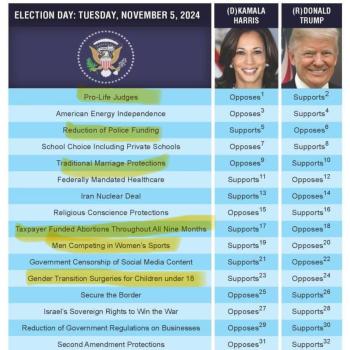I haven’t posted yet this week, although I normally post twice each week. The fact is, I have been wrestling with the idea of posting this book review.
The candid reality of our President’s speech on Tuesday night greatly impressed me. As someone who lived in California for nearly half my life, I believe he covered some important points for us all to consider about our southern border.
I seldom use this platform for a piece on ethics and society. However, I believe Christians can and should use their voice as change agents. So I offer this book review from 2017 to explore another perspective, half today and the second half tomorrow.[1]
I greatly respect the works of Justo Gonzalez, Ph.D. He is a tremendous Church historian. This book is Santa Biblia: The Bible Through Hispanic Eyes. If you decide to purchase it, follow my Amazon link in the footnotes.[2] Because this is a single book review, I do not use multiple footnote citations, but rather include the page numbers in-line.
After the second half of the book review tomorrow, I will offer my critique of some of Gonzalez’s views, including his ideas on the border.
Marginality, Poverty, & the Border
 Fae | Border patrol car patroling on border | 03.01.18 | Public Domain
Fae | Border patrol car patroling on border | 03.01.18 | Public Domain
Introduction
The Theology of Justo L. Gonzalez stands at the crossroads of Latin America and America, Hispanic Protestant Methodists and Catholics, Fundamentalism and the authority of Scripture in reading communities, Historical-Critical and Neo-Orthodoxy, Modernity and Postmodernity. However his perspective is often off the radar of the Western Church. “Yet in some ways what I say here, rather than ‘postmodern,’ hopes to express some of the ‘extramodern’ experience of a community that was largely excluded from modernity – or rather, that was included as an object rather than as a subject” (15). He also uses the terms “premodern” or “precritical.” Hispanics approach the Text unencumbered by Western Theology and philosophy (22).
Gonzalez deconstructs perspectives claiming to have all the answers. “Any theology that claims universality is by definition sectarian and divisive” (17). He applies this to the current study, calling it “a Hispanic perspective,” not, “the Hispanic perspective” (19).
The thesis or purpose of the book seems to be stated in the last sentence of the introduction. “Our purpose is to explore and to show what ‘Hispanic eyes’ or a Latino perspective can contribute to the understanding of the Scripture, not only on the part of Hispanics, but also of those others who, albeit from different perspectives, share the same landscape and the same faith with us” (30).
Chapter 1: Marginality
Chapter titles are central to the book composition
“I have decided to organize what follows around five paradigms or perspectives that Latinos employ when reading both the Bible and their own situation” (32). The first chapter is Marginality. The idea of a “polycentric society” is that Hispanics stand on the margins in some ways and in the center in other ways (33).
The marginalized often intentionally make space for themselves on the fringes as well (33-34). Latino Protestants are also marginalized by Catholics.
Gonzalez shows how the marginalized approach Scripture
He interprets Acts, revealing how those on the outskirts influence those in the center, often becoming the driving force (34-35f). The mission becomes the headquarters, a theme not only repeated in Acts, but throughout Church History. “Marginality also helps us to understand why those in the center have so much difficulty being truly evangelistic” (41).
He supports this with a series of arguments from the Old Testament, New Testament, accounts in Acts of Peter and Paul, etc. (43-52). One theme is that Gentiles are welcomed into the Church, or resisted at times because their masses begin to dilute the voices of the Hebrews. Another theme is that the center of the New Testament and Early Church reaches out to convert those on the fringes, but is also converted again in the process to be able to accept those on the fringes.
Gonzalez draws parallels between the stories of Jonah and Peter
This is the story of Peter and Cornelius (42-43, 48-49). Peter is in Joppa. He is Simon son of Jonah. He is called to Caesarea, an empire bastion, a metro comparable to Nineveh. Neither Jonah nor Peter want to obey because they do not want to reach outsiders, knowing that God will restore.
Peter reluctantly follows the Spirit step by step, “until he is finally ready to share his message with these latter-day Ninevites” (49). Gonzalez argues that denominations do the same thing, holding to the center, supporting foreign missions, but not the fields at home. We are afraid of reaching those in need because they will affect us, cause us to change, a problem he calls the “Jonah Syndrome” (54).
Western denominations are declining for various reasons. “But ultimately the reason why we are declining is that we have lost our sense of mission, and in so doing have lost one of the great sources from which the church has traditionally been renewed” (55).
Chapter 2: Poverty
Gonzalez cites one statistical correlation
Poverty rates and similar issues find Hispanics at 150% worse than the rest of the population (57). He does not bemoan this, but turns to how the impoverished look at Scripture, posing questions of the Text. “What do the poor find in the Bible that is an important message to the entire church?” (58). One Latin preacher asks about Sabbath law, “How, then, are we to obey the law of God, that commands that we shall work six days, when we cannot even find work for a single day?” (60).
koinonia
Gonzalez reports arguments against the utopian idealistic koinonia of the Primitive and Early Churches. Then he defends it from the Didache, Epistle of Barnabas, and from Tertullian who writes tongue-in-cheek: “All of us who are joined in one heart and soul do not hesitate in sharing material goods. All things are common among us, except women” (68). He also defends it from within the Text. Greek verbs in Acts are in the “imperfect tense” referring to ongoing action in the past (69).
Gonzalez offers a word study on koinonia as partnership more than fellowship or communion. “Whenever the church is spoken of as a koinonia, what is meant is, among other things, a company in which all are equal stakeholders, so that all each has is at the disposal of the rest” (71). He argues for expanding koinonia worldwide relying Scriptures about the offering collected among the Gentile congregations for the Jerusalem Christians. This economic koinonia does not die out as a Primitive Church experiment, but is replicated in the communities of faith for generations. Latinos as an example of those in need. Gonzalez calls upon the church to return to this hallmark of our heritage.
Chapter 3: Mestizaje and Mulatez
Gonzalez defines terms like mestizos, mulattos, and mestizaje
He explores the interrelations of Spanish, British, African, and Native Americans. He offers a word study with historical analysis of Saul of Tarsus, who is also Paul – Acts 13.9 (80-83). Paul stands at an intersection between cultures, not unlike mestizos and mulattos. He changes his name when he moves from the Jewish to the Greek world, when Antioch launches him on his first mission with Barnabas (Acts 13). “It is because Saul is also Paul, because the Jewish scholar is also capable of moving in Hellenistic and Roman circles, that he becomes the great apostle to the Gentiles” (83).
Gonzalez makes applications that seem to be political
Neither of the parent’s cultures, neither parent’s culture accepts the mestizo or mulatto, nor does he seem to accept himself. From the dominant culture mindset, Gonzalez claims that the motivation for secure borders in America is all about a pure race (83-84).
There is a distinction between a border and a frontier. In his opinion, Spanish settlers sought to rule over Native Americans south of the U.S.A., establishing borders that were crossable by either side. However, he believes the British tried to push indigenous Americans back from the frontier, and sought to exterminate them (84-85).
Gonzalez uses border and frontier as a Christian metaphor
He calls for a border (82-87). He seems to paint with broad strokes, with elements of truth that he applies to the Church’s mission. A frontier is unidirectional pushing back others. A border is bidirectional and can be crossed from either side (86).
“The church’s growing edge, rather than an impermeable frontier that simply advances, is more like a border, in which advance also implies learning from the new context” (87).
notes:
[1] Jared V. Ingle, “Review of Justo L. Gonzalez, Santa Biblia: The Bible Through Hispanic Eyes” (paper presented in, New Testament Introduction, Asbury Theological Seminary, March 26, 2017).pt 2: Santa Biblia: Immigrants, Solidarity, and My Critique
[2] Justo L. Gonzalez, Santa Biblia: The Bible Through Hispanic Eyes (Nashville, TN: Abingdon Press, 1996).












